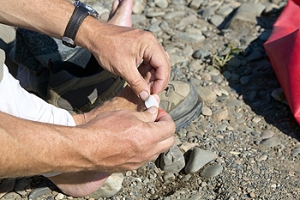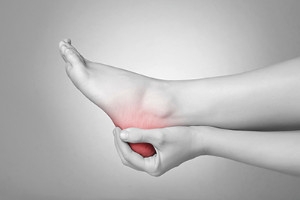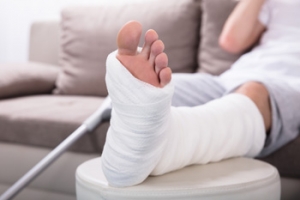
What Leads to Plantar Fasciitis?
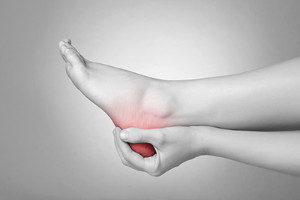 The plantar fascia is a strong and thick tissue that runs along the bottom of the foot and connects the heel bone to the toes. Plantar fasciitis occurs when this piece of tissue becomes inflamed or torn. Generally, plantar fasciitis is caused by overstretching or overuse and causes heel pain. Common reasons for overuse include playing sports that stress the heel bone, being overweight, pregnant, or middle-aged, or spending too much time standing. Patients who are experiencing heel pain associated with plantar fasciitis will notice that the heel pain is the worst in the morning after resting, after a long period of sitting or standing, or after physical activity. Patients who believe that they may be experiencing plantar fasciitis should consult with a podiatrist for a proper diagnosis and treatment method.
The plantar fascia is a strong and thick tissue that runs along the bottom of the foot and connects the heel bone to the toes. Plantar fasciitis occurs when this piece of tissue becomes inflamed or torn. Generally, plantar fasciitis is caused by overstretching or overuse and causes heel pain. Common reasons for overuse include playing sports that stress the heel bone, being overweight, pregnant, or middle-aged, or spending too much time standing. Patients who are experiencing heel pain associated with plantar fasciitis will notice that the heel pain is the worst in the morning after resting, after a long period of sitting or standing, or after physical activity. Patients who believe that they may be experiencing plantar fasciitis should consult with a podiatrist for a proper diagnosis and treatment method.
Plantar fasciitis can be very painful and inconvenient. If you are experiencing heel pain or symptoms of plantar fasciitis, contact John McGhan, DPM from Gold Canyon Foot & Ankle. Our doctor can provide the care you need to keep you pain-free and on your feet.
What Is Plantar Fasciitis?
Plantar fasciitis is the inflammation of the thick band of tissue that runs along the bottom of your foot, known as the plantar fascia, and causes mild to severe heel pain.
What Causes Plantar Fasciitis?
- Excessive running
- Non-supportive shoes
- Overpronation
- Repeated stretching and tearing of the plantar fascia
How Can It Be Treated?
- Conservative measures – anti-inflammatories, ice packs, stretching exercises, physical therapy, orthotic devices
- Shockwave therapy – sound waves are sent to the affected area to facilitate healing and are usually used for chronic cases of plantar fasciitis
- Surgery – usually only used as a last resort when all else fails. The plantar fascia can be surgically detached from the heel
While very treatable, plantar fasciitis is definitely not something that should be ignored. Especially in severe cases, speaking to your doctor right away is highly recommended to avoid complications and severe heel pain. Your podiatrist can work with you to provide the appropriate treatment options tailored to your condition.
If you have any questions please feel free to contact our office located in Gold Canyon, AZ . We offer the newest diagnostic and treatment technologies for all your foot and ankle needs.
Plantar Fasciitis
The plantar fascia is a connective tissue in the heel that stretches across the bottom length of your foot. Plantar fasciitis occurs when the connective tissue becomes inflamed, causing heel pain and discomfort during physical activity. Although the condition is completely treatable, traditional methods can take up to a year to start becoming effective.
Plantar fasciitis is caused by a number of everyday activities, so understanding the condition is important for managing and treating it. One of the most common causes of plantar fasciitis is excessive running, especially with improper fitting or non-supportive shoes. Too much exercise can lead to the plantar fascia being overworked and overstretched, which can cause tears in the tissue. Along with improper fitting shoes, pronation, the rolling of the feet inward, is a common cause of plantar fasciitis. If not treated properly, the plantar fascia becomes overstretched and starts to tear, causing inflammation.
Despite the common causes of plantar fasciitis, there are many different treatment options. For less severe cases, conservative home remedies include taking anti-inflammatory drugs to alleviate pain, applying ice packs to the bottom of your foot and heel, slowly stretching and exercising your feet to re-strengthen the tissue, and using orthotic devices are all ways to help manage your plantar fasciitis.
For more severe cases, shockwave therapy has become a common solution for plantar fasciitis. Shockwave therapy can effectively break up the tissue on the bottom of your foot which facilitates healing and regeneration. This fights the chronic pain caused by plantar fasciitis. Even if this doesn’t work, surgery is always a final option. Surgery on the tissue itself can be done to permanently correct the issue and stop the inflammation and pain in your heels.
No matter what the case may be, consulting your podiatrist is the first and best step to recovery. Even the slightest amount of heel pain could be the first stage of plantar fasciitis. Untreated symptoms can lead to the tearing and overstretching of tissue. Because the tearing of tissue can be compounded if it remains ignored, it can evolve into a severe case. The solution is early detection and early treatment. Talk to your podiatrist about the possibilities of plantar fasciitis if you’re experiencing heel pain.
Why Live with Pain and Numbness in Your Feet?
Can Flip Flops Hurt My Feet?
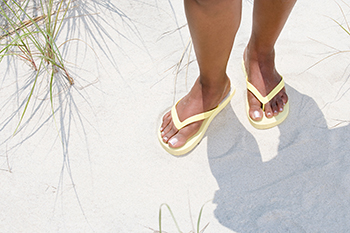 There are so many different styles of shoes that are available for purchase, but flip flops are often the quick go to and one of the most dangerous to frequently wear. Various foot conditions may develop as a result of wearing flip flops and most can cause severe pain and discomfort. Some of these ailments can include blisters, corns, arch pain, Achilles tendonitis, and most commonly plantar fasciitis or heel pain. It is a natural reaction for the toes to grip the front of the shoe in an effort to have them stay on the feet. This can lead to aching and soreness throughout the entire foot. If flip flops are still your top choice to wear it can be beneficial to rotate them with other styles of flip flops. Sandals that have a strap around the heel can also be less harmful to the feet and it may help to wear high-quality flips flops that are constructed of leather materials. Additionally, it is suggested to refrain from wearing socks with flip flops as this can cause foot strain too. If you have questions about how to choose the right flip flops for you, please consult with a podiatrist.
There are so many different styles of shoes that are available for purchase, but flip flops are often the quick go to and one of the most dangerous to frequently wear. Various foot conditions may develop as a result of wearing flip flops and most can cause severe pain and discomfort. Some of these ailments can include blisters, corns, arch pain, Achilles tendonitis, and most commonly plantar fasciitis or heel pain. It is a natural reaction for the toes to grip the front of the shoe in an effort to have them stay on the feet. This can lead to aching and soreness throughout the entire foot. If flip flops are still your top choice to wear it can be beneficial to rotate them with other styles of flip flops. Sandals that have a strap around the heel can also be less harmful to the feet and it may help to wear high-quality flips flops that are constructed of leather materials. Additionally, it is suggested to refrain from wearing socks with flip flops as this can cause foot strain too. If you have questions about how to choose the right flip flops for you, please consult with a podiatrist.
Flip-flops can cause a lot of problems for your feet. If you have any concerns about your feet or ankles, contact John McGhan, DPM from Gold Canyon Foot & Ankle. Our doctor will assist you with all of your foot and ankle needs.
Flip-Flops and Feet
Flip-flops have managed to become a summer essential for a lot of people. While the shoes may be stylish and easy to slip on and off, they can be dangerous to those who wear them too often. These shoes might protect you from fungal infections such as athlete’s foot, but they can also give you foot pain and sprained ankles if you trip while wearing them.
When Are They Okay to Wear?
Flip-flops should only be worn for very short periods of time. They can help protect your feet in places that are crawling with fungi, such as gym locker rooms. Athlete’s foot and plantar warts are two common fungi that flip-flops may help protect your feet against.
Why Are They Bad for My Feet?
These shoes do not offer any arch support, so they are not ideal for everyday use. They also do not provide shock absorption or heel cushioning which can be problematic for your feet. Additionally, you may suffer from glass cuts, puncture wounds, and stubbed toes since they offer little protection for your feet.
More Reasons Why They Are Bad for Your Feet
- They Slow You Down
- May Cause Blisters and Calluses
- Expose Your Feet to Bacteria
If you have any questions, please feel free to contact our office located in Gold Canyon, AZ . We offer the newest diagnostic and treatment technologies for all your foot care needs.
Flipping Out About Flip Flops
Although it may be tempting to wear flip-flops in warm weather, they are not the best choice of footwear for your feet. Flip-flops may be ideal for the beach, pool, spa, and shared showers, but you should avoid wearing them unless it is completely necessary.
Flip-flops only have a small strip of fabric holding your foot in place, but your toes need a better grip to keep your foot in place. The repetitive gripping can lead to an overuse of your muscles, which could result in tendinitis. This is only one of the many problems that stem from wearing flip-flops too often.
Flip flops aren’t good for extensive walking because they fail to offer arch support, heel cushioning, or shock absorption. As a result, people who wear flip flops are at a higher risk of experiencing an ankle sprain. Additionally, these shoes offer little protection for your feet, putting those who wear them at a greater risk for stubbed toes, glass cuts, and puncture wounds.
Although flip flops aren’t recommended for everyday use by anyone, it is especially important for diabetics to avoid them. A diabetic foot injury can easily become very serious, and it may even lead to amputation.
If you are experiencing pain from wearing flip-flops, you shouldn’t be hesitant to replace them with a more comfortable shoe that offers more support. If your flip-flop foot pain doesn’t go away, you should seek assistance from a podiatrist right away. It is possible that you may have a more serious foot problem such as a stress fracture or arthritis.
Why Do I Have Blisters on My Feet?
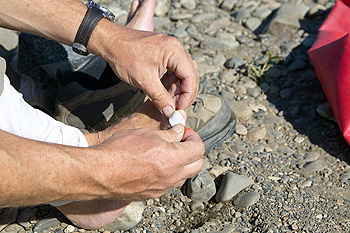 Most blisters form on the feet due to friction. As you walk, your shoes or socks may rub against a small area of skin, damaging it. A pocket of fluid builds up underneath the damaged skin to shield the deeper layers of skin from further damage. Friction blisters are best left alone and footwear and activity modifications are often adequate for treating symptoms and preventing future blisters. However, not all foot blisters are caused by friction. Blisters can also occur on the feet due to allergic reactions, exposure to certain chemicals, skin conditions like eczema, frostbite, sunburn, and fungal, viral, or bacterial infections. If you frequently have blisters on your feet, a podiatrist can help you determine the cause of your blisters and find the best treatment for you.
Most blisters form on the feet due to friction. As you walk, your shoes or socks may rub against a small area of skin, damaging it. A pocket of fluid builds up underneath the damaged skin to shield the deeper layers of skin from further damage. Friction blisters are best left alone and footwear and activity modifications are often adequate for treating symptoms and preventing future blisters. However, not all foot blisters are caused by friction. Blisters can also occur on the feet due to allergic reactions, exposure to certain chemicals, skin conditions like eczema, frostbite, sunburn, and fungal, viral, or bacterial infections. If you frequently have blisters on your feet, a podiatrist can help you determine the cause of your blisters and find the best treatment for you.
Blisters are prone to making everyday activities extremely uncomfortable. If your feet are hurting, contact John McGhan, DPM of Gold Canyon Foot & Ankle. Our doctor can provide the care you need to keep you pain-free and on your feet.
Foot Blisters
Foot blisters develop as a result of constantly wearing tight or ill-fitting footwear. This happens due to the constant rubbing from the shoe, which can often lead to pain.
What Are Foot Blisters?
A foot blister is a small fluid-filled pocket that forms on the upper-most layer of the skin. Blisters are filled with clear fluid and can lead to blood drainage or pus if the area becomes infected.
How Do Blisters Form?
Blisters on the feet are often the result of constant friction of skin and material, usually by shoe rubbing. Walking in sandals, boots, or shoes that don’t fit properly for long periods of time can result in a blister. Having consistent foot moisture and humidity can easily lead to blister formation.
Prevention & Treatment
It is important to properly care for the affected area in order to prevent infection and ease the pain. Do not lance the blister and use a Band-Aid to provide pain relief. Also, be sure to keep your feet dry and wear proper fitting shoes. If you see blood or pus in a blister, seek assistance from a podiatrist.
If you have any questions, please feel free to contact our office located in Gold Canyon, AZ . We offer the newest diagnostic and treatment technologies for all your foot care needs.
Blisters
Blisters are pockets of fluid that occur under the top layer of your skin. These fluid pockets are usually filled with pus, blood, or serum. Blisters may itch or hurt and can appear as a single bubble or in clusters.
The most common types of blisters are friction blisters. This type of blister may be caused by wearing shoes that are too tight. Friction blisters can also occur on the hands. A change in temperature may also cause blisters on the feet. In the freezing air, frostbite on your toes can lead to blisters, as well as sunburn from hot weather.
The best way to treat a blister is to keep it clean and dry. Most blisters will get better on their own. Once the skin absorbs the fluid within the blister, it will flatten and eventually peel off. You should avoid popping your blister unless you podiatrist does it for you. Additional treatment options include applying an ice pack to the blister or using over-the-counter blister bandages to cover the affected area.
If your blister becomes discolored, inflamed, or worsens it is advised that you speak to your podiatrist. Blisters that are yellow, green, or purple may be infected and require immediate medical attention. Blisters that are abnormally colored may be a sign of a more serious underlying health condition such as herpes.
Children Limping May Indicate Sever’s Disease
 Active children may be more likely to experience heel pain. This pain can be indicative of a condition known as Sever’s disease, and it often affects children and young adolescents. This uncomfortable ailment affects the growth plate in the heel and can occur as a result of extensive pressure exerted on the area where the Achilles tendon meets the heel. Parents may notice their child limping, in addition to experiencing a decrease in flexibility. Prompt treatment generally begins with stopping the activity that caused this condition, and it is beneficial to rest the affected foot. Some children find it may help to perform specific stretches that target the Achilles tendon and calf. If you notice your child has symptoms of Sever’s disease, it is strongly suggested that you schedule a consultation with a podiatrist who can determine what the most effective treatment is.
Active children may be more likely to experience heel pain. This pain can be indicative of a condition known as Sever’s disease, and it often affects children and young adolescents. This uncomfortable ailment affects the growth plate in the heel and can occur as a result of extensive pressure exerted on the area where the Achilles tendon meets the heel. Parents may notice their child limping, in addition to experiencing a decrease in flexibility. Prompt treatment generally begins with stopping the activity that caused this condition, and it is beneficial to rest the affected foot. Some children find it may help to perform specific stretches that target the Achilles tendon and calf. If you notice your child has symptoms of Sever’s disease, it is strongly suggested that you schedule a consultation with a podiatrist who can determine what the most effective treatment is.
Sever's disease often occurs in children and teens. If your child is experiencing foot or ankle pain, see John McGhan, DPM from Gold Canyon Foot & Ankle. Our doctor can treat your child’s foot and ankle needs.
Sever’s Disease
Sever’s disease is also known as calcaneal apophysitis, which is a medical condition that causes heel pain I none or both feet. The disease is known to affect children between the ages of 8 and 14.
Sever’s disease occurs when part of the child’s heel known as the growth plate (calcaneal epiphysis) is attached to the Achilles tendon. This area can suffer injury when the muscles and tendons of the growing foot do not keep pace with bone growth. Therefore, the constant pain which one experiences at the back of the heel will make the child unable to put any weight on the heel. The child is then forced to walk on their toes.
Symptoms
Acute pain – Pain associated with Sever’s disease is usually felt in the heel when the child engages in physical activity such as walking, jumping and or running.
Highly active – Children who are very active are among the most susceptible in experiencing Sever’s disease, because of the stress and tension placed on their feet.
If you have any questions, please feel free to contact our office located in Gold Canyon, AZ . We offer the newest diagnostic and treatment technologies for all your foot and ankle injuries.
Sever's Disease
Sever’s disease, also known as calcaneal apophysitis is a common bone disorder that occurs during childhood. The disease is defined as an inflammation of the growth plate in the heel. When a child has a growth spurt, his heel bone grows faster than the muscles, tendons, and ligaments in his leg. This disease is a result of overuse. The people who are most likely to be affected by this disease are children who are in a growth spurt, especially boys who are from the ages of 5 to 13 years old. 60% of children with Sever’s disease have both heels involved.
Symptoms of this disease are heel pain that intensifies during running and jumping activities. The pain is typically localized to the posterior part of the heel. Symptoms may be severe, and they can easily interfere with daily activities. Children who play soccer, baseball, and basketball are more likely to develop Sever’s disease.
Your doctor will diagnose your child based on his or her symptoms, x-rays are generally not helpful in diagnosing this disease. Your doctor may examine both heels and ask your child questions about his or her activity level in sports. Your doctor may then use the squeeze test on your child’s heel to see if there is any pain. Nevertheless, some doctors might still use x-rays to rule out any other issues such as fractures, infections, and tumors.
Sever’s disease can be prevented by maintaining good flexibility while your child is growing. Another prevention method is to wear good-quality shoes that have firm support and a shock-absorbent sole. Sever’s disease can be treated by ceasing any activity that causes heel pain. You should apply ice to the injured heel for 20 minutes 3 times a day. Additionally, orthotics should be used for children who have high arches, flat feet, or bowed legs.
If you suspect your child has Sever’s disease, you should make an appointment with your podiatrist to have his or her foot examined. Your doctor may recommend nonsteroidal anti-inflammatory drugs (NSAIDs), such as ibuprofen or naproxen to relieve pain. In more severe cases, your child may need a cast to rest his or her heel. Fortunately, Sever’s disease does not cause long-term foot problems. After treatment, your child should start to feel better within two weeks to two months.
Signs Your Child Has a Broken Foot
 The symptoms of a foot fracture in children are often noticeable. Your child may complain of pain while walking, the foot may change shape, and can become swollen. It can happen from enduring a sudden fall, and an X-ray is often needed for a proper diagnosis. A common form of treatment is to have your child wear a cast, which is helpful in keeping the foot stable as the healing process occurs. Additionally, frequently elevating the affected foot may be beneficial in diminishing existing swelling. Surgery may be required if the fracture is severe or if the bone protrudes from the foot. If you know your child has fallen, is limping, and has difficulty walking, please consult with a podiatrist as quickly as possible so that your child can begin the correct course of treatment.
The symptoms of a foot fracture in children are often noticeable. Your child may complain of pain while walking, the foot may change shape, and can become swollen. It can happen from enduring a sudden fall, and an X-ray is often needed for a proper diagnosis. A common form of treatment is to have your child wear a cast, which is helpful in keeping the foot stable as the healing process occurs. Additionally, frequently elevating the affected foot may be beneficial in diminishing existing swelling. Surgery may be required if the fracture is severe or if the bone protrudes from the foot. If you know your child has fallen, is limping, and has difficulty walking, please consult with a podiatrist as quickly as possible so that your child can begin the correct course of treatment.
A broken foot requires immediate medical attention and treatment. If you need your feet checked, contact John McGhan, DPM from Gold Canyon Foot & Ankle. Our doctor can provide the care you need to keep you pain-free and on your feet.
Broken Foot Causes, Symptoms, and Treatment
A broken foot is caused by one of the bones in the foot typically breaking when bended, crushed, or stretched beyond its natural capabilities. Usually the location of the fracture indicates how the break occurred, whether it was through an object, fall, or any other type of injury.
Common Symptoms of Broken Feet:
- Bruising
- Pain
- Redness
- Swelling
- Blue in color
- Numbness
- Cold
- Misshapen
- Cuts
- Deformities
Those that suspect they have a broken foot shoot seek urgent medical attention where a medical professional could diagnose the severity.
Treatment for broken bones varies depending on the cause, severity and location. Some will require the use of splints, casts or crutches while others could even involve surgery to repair the broken bones. Personal care includes the use of ice and keeping the foot stabilized and elevated.
If you have any questions please feel free to contact our office located in Gold Canyon, AZ . We offer the newest diagnostic and treatment technologies for all your foot and ankle needs.




